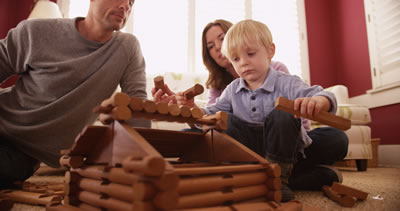Dear Families,
The hardwood unit blocks you see in our classroom are among our most valuable learning materials. They come in proportional sizes and various shapes. When children build with blocks, they begin to understand math concepts. For example, they learn about volume when they find the number of blocks that fill a certain space. They compare the heights of their buildings and learn about geometric shapes (triangles, squares, and rectangles). When they lift, shove, stack, and move blocks, they explore weight and size. Each time they use blocks, children make decisions about how to build structures and solve construction problems.
Children often use blocks to represent the world around them, perhaps a road, a house, or a zoo. As they work together, they learn to cooperate and begin to understand friendship. To promote language development and expand children’s play, encourage them to talk about what they are doing. Here are examples of what you might say and ask:
“I see that you made a tall apartment building. How do people get to their floors?”
“Where do people park their cars when they come to the shopping center?”
“Would you like to make a sign for your building?”
These questions and comments make children more aware of what they are doing and encourage them to try new ideas.
What You Can Do at Home
You can encourage your child to learn through block play by taking an interest in what he or she does at our program. Please spend time in our Block area to see your child building with and caring for blocks. When you take a walk in your neighborhood, point out roads and interesting buildings. You may want to purchase table blocks, colored wooden cube blocks, or cardboard brick blocks to have at home. You can also make a set out of milk cartons, which come in different sizes. Store them in shoe boxes or plastic tubs and put a picture and word label on the container so your child knows where the materials belong.
Identify a place where your child can build and play with blocks safely. Props such as clothespins, small plastic animals, and cars and trucks will extend your child’s play.

